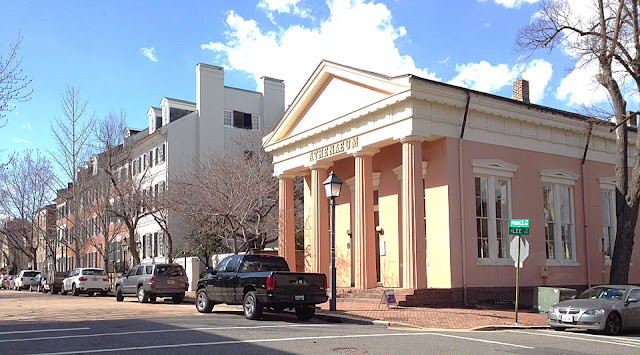Mostly historic architecture is included this year (taking a cue from our walk-off host), on what was the more affluent side of town, where homes are brick (instead of wood), and are three stories (instead of two). All photos were taken with my cellphone -- a first (and a test) for this blog.
 Stabler Leadbeater Apothecary Shop is now a museum, but provided compounds and cures for years -- like to George Washington. Love the unique curved glass in the windows. On a tour, I remember seeing containers labeled "Dragon's Blood" and "Hound's Tooth." (I could not find eye of newt or wing of bat.) A curator mentioned that some compounds were unknown or labeled with strange names, and that no one today knows what they are, where they came from, or what they were used for. This 'drug' company operated until the 1900s when the newly formed FDA began requiring disclosure and regulation of ingredients in pharmaceuticals (and proof that they were effective.)
Stabler Leadbeater Apothecary Shop is now a museum, but provided compounds and cures for years -- like to George Washington. Love the unique curved glass in the windows. On a tour, I remember seeing containers labeled "Dragon's Blood" and "Hound's Tooth." (I could not find eye of newt or wing of bat.) A curator mentioned that some compounds were unknown or labeled with strange names, and that no one today knows what they are, where they came from, or what they were used for. This 'drug' company operated until the 1900s when the newly formed FDA began requiring disclosure and regulation of ingredients in pharmaceuticals (and proof that they were effective.) This plaque tells the story ... of a building across from the firehouse. The building is in the left-center of the photo below.
This plaque tells the story ... of a building across from the firehouse. The building is in the left-center of the photo below. Two blocks away, another firehouse, the Friendship Firehouse is now a museum.
Two blocks away, another firehouse, the Friendship Firehouse is now a museum. This was building was entrance to (what else) the Elks Club, and is now full of condos.
This was building was entrance to (what else) the Elks Club, and is now full of condos. And here is another spite house. The most famous one in town was profiled in a previous year's walk-off. Look for the door to the basement ice chamber.
And here is another spite house. The most famous one in town was profiled in a previous year's walk-off. Look for the door to the basement ice chamber. Examples of the wealthy homes built in the 1800s. Most are in an Italianate style -- fitting the more conservative residents.
Examples of the wealthy homes built in the 1800s. Most are in an Italianate style -- fitting the more conservative residents. This is one of my favorites -- but the owners were probably outcasts and snubbed for building such a highly decorative, flamboyant house - a MacMansion of the time.
This is one of my favorites -- but the owners were probably outcasts and snubbed for building such a highly decorative, flamboyant house - a MacMansion of the time.
 Gentry Row is a block of townhomes built by wealthy merchants. Brick paving in the street is cool.
Gentry Row is a block of townhomes built by wealthy merchants. Brick paving in the street is cool. Captain's Row is a block with many homes built by wealthy sea captains. This street, a bit older, is paved with cobblestones.
Captain's Row is a block with many homes built by wealthy sea captains. This street, a bit older, is paved with cobblestones. This museum is a stunner. It was originally a bank, right in the middle of a residential neighborhood at the end of Gentry Row -- before zoning regulations.
This museum is a stunner. It was originally a bank, right in the middle of a residential neighborhood at the end of Gentry Row -- before zoning regulations. Stinky, dirty, smelly warehouses were found down near the river near the docks and wharfs.
Stinky, dirty, smelly warehouses were found down near the river near the docks and wharfs. A newer building near the river marks the water elevation. The river is at sea level, and does flood. When severe, water comes up into the lower streets and buildings. In recent years, this happens more frequently.
A newer building near the river marks the water elevation. The river is at sea level, and does flood. When severe, water comes up into the lower streets and buildings. In recent years, this happens more frequently.2015 Walk-Off
2014 Walk-Off
2013 Walk-Off
Hope you enjoyed your history lesson and tourist promo. Visit other winter walk-offs with Les at A Tidewater Gardener.





